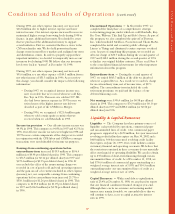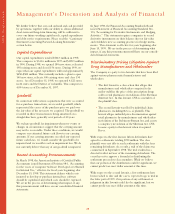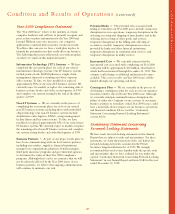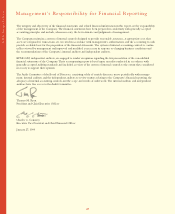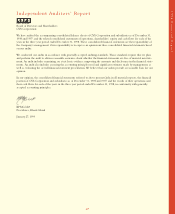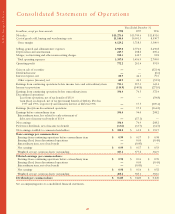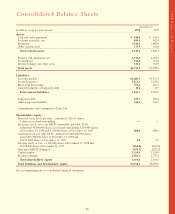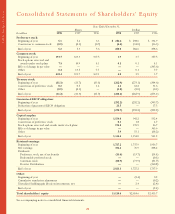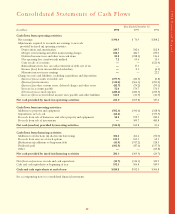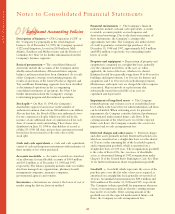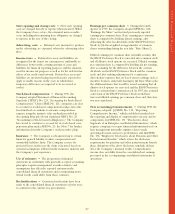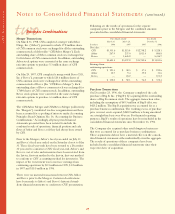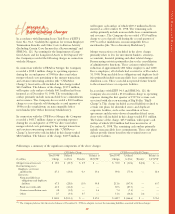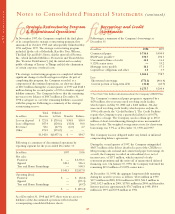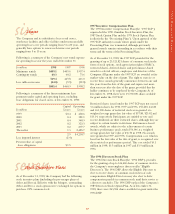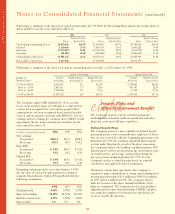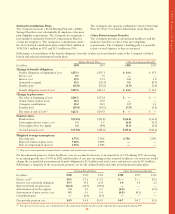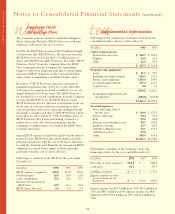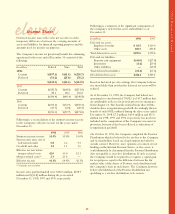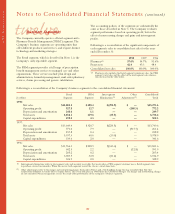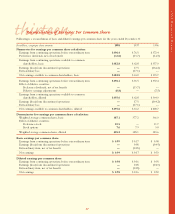CVS 1998 Annual Report Download - page 29
Download and view the complete annual report
Please find page 29 of the 1998 CVS annual report below. You can navigate through the pages in the report by either clicking on the pages listed below, or by using the keyword search tool below to find specific information within the annual report.
1998 Financial Report
27
Store opening and closing costs ~ New store opening
costs are charged directly to expense when incurred. When
the Company closes a store, the estimated unrecoverable
costs, including the remaining lease obligation, are charged
to expense in the year of the closing.
Advertising costs ~ External costs incurred to produce
media advertising are expensed when the advertising takes
place.
Income taxes ~ Deferred tax assets and liabilities are
recognized for the future tax consequences attributable to
differences between the carrying amount of assets and
liabilities for financial reporting purposes and the amounts
used for income tax purposes as well as for the deferred tax
effects of tax credit carryforwards. Deferred tax assets and
liabilities are measured using enacted tax rates expected to
apply to taxable income in the years in which those
temporary differences are expected to be recovered or
settled.
Stock-based compensation ~ During 1996, the
Company adopted Statement of Financial Accounting
Standards (“SFAS”) No. 123, “Accounting for Stock-Based
Compensation.” Under SFAS No. 123, companies can elect
to account for stock-based compensation using a fair value
based method or continue to measure compensation
expense using the intrinsic value method prescribed in
Accounting Principles Board Opinion (“APB”) No. 25,
“Accounting for Stock Issued to Employees.” The Company
has elected to continue to account for its stock-based com-
pensation plans under APB No. 25. See Note 7 for further
information about the Company’s stock incentive plans.
Insurance ~ The Company is self-insured up to certain
limits for general liability, workers compensation and
automobile liability claims. The Company accrues for
projected losses in the year the claim is incurred based on
actuarial assumptions followed in the insurance industry and
the Company’s past experience.
Use of estimates ~ The preparation of financial
statements in conformity with generally accepted accounting
principles requires management to make estimates and
assumptions that affect the reported amounts in the
consolidated financial statements and accompanying notes.
Actual results could differ from those estimates.
Reclassifications ~ Certain reclassifications have been
made to the consolidated financial statements of prior years
to conform to the current year presentation.
Earnings per common share ~ During the fourth
quarter of 1997, the Company adopted SFAS No. 128,
“Earnings Per Share” and restated previously reported
earnings per common share. Basic earnings per common
share is computed by dividing: (i) net earnings, after
deducting the after-tax dividends on the ESOP Preference
Stock, by (ii) the weighted average number of common
shares outstanding during the year (the “Basic Shares”).
Diluted earnings per common share normally assumes that
the ESOP Preference Stock is converted into common stock
and all dilutive stock options are exercised. Diluted earnings
per common share is computed by dividing: (i) net earnings,
after accounting for the difference between the current
dividends on the ESOP Preference Stock and the common
stock and after making adjustments for certain non-
discretionary expenses that are based on net earnings such as
incentive bonuses and profit sharing by (ii) Basic Shares plus
the additional shares that would be issued assuming that all
dilutive stock options are exercised and the ESOP Preference
Stock is converted into common stock. In 1997, the assumed
conversion of the ESOP Preference Stock would have
increased diluted earnings per common share and, therefore,
was not considered.
New accounting pronouncements ~ During 1998, the
Company adopted: (i) SFAS No. 130, “Reporting
Comprehensive Income,” which established standards for
the reporting and display of comprehensive income and its
components, (ii) SFAS No. 131, “Disclosures about
Segments of an Enterprise and Related Information,” which
requires companies to report financial information based on
how management internally organizes data to make
operating decisions and assess performance and (iii) SFAS
No. 132, “Employers’ Disclosures about Pensions and Other
Postretirement Benefits,” which revises the disclosure
requirements for pensions and other postretirement benefit
plans. Adoption of the above disclosure standards did not
affect the Company’s financial results. Comprehensive
income does not differ from the consolidated net earnings
presented in the accompanying consolidated statements of
operations.


